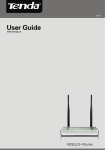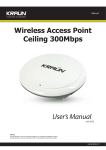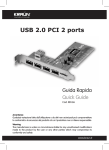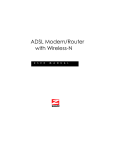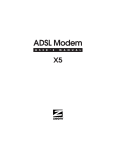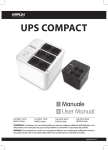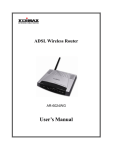Download User's Manual ADSL2/2+ Wireless-N Router 150Mbps plus
Transcript
Manual ADSL2/2+ Wireless-N Router 150Mbps plus User’s Manual Cod. KN.2R Warning The manufacturer is under no circumstances liable for any unauthorised modifications made to the product by the user or any other parties which may compromise its conformity and safety. www.kraun.it Manual TABLE OF CONTENTS Chapter 1. Product Overview 4 1.1 Product Features 1.2 Package Contents 1.3 Factory Defaults 4 5 5 Chapter 2. Hardware Description 6 2.1 Panel Layout 2.1.1 Front Panel 2.1.2 Back Panel 2.2 Hardware Connection 6 6 7 7 Chapter 3. Fast configuration 8 3.1 Logging on to your router through Web browser 3.2 Fast Internet Access Chapter 4. Advanced Settings 8 10 13 4.1 Device Information 4.2 Advanced Setup 4.2.1 Connection mode 4.2.2 WAN Service 1. WAN Configuration in DSL Mode 14 17 17 19 19 PPP over Ethernet (PPPoE) 19 IP over Ethernet 23 Bridging 27 PPPOA 28 IPOA 2. WAN Configuration in Ethernet Mode 32 35 PPP over Ethernet (PPPoE) 35 IP over Ethernet 4.2.3 LAN 4.2.4 DHCP setting 38 41 41 DHCP Server 41 DHCP client 4.2.5 NAT 42 43 Virtual Server 4.2.6 Port Triggering 4.2.7 DMZ Host 4.2.8 Security 43 45 47 48 IP Filter 48 URL Filter 4.2.9 Time Restriction 4.2.10 Quality of Service 50 51 52 Queue Configuration 4.2.11 Routing 52 53 Default Gateway 53 Static Route 54 2 www.kraun.it Manual 4.2.12 DNS 55 DNS server 55 DDNS 4.2.13 4.2.14 4.2.15 4.2.16 55 56 57 57 58 DSL UPnP Interface Grouping Multicast IGMP Configuration 4.3 Wireless Setting 4.3.1 Basic Setting 58 58 58 Wireless Mode: 4.3.2 Security Setting 4.3.3 MAC Filter 4.3.4 Wireless Bridge 4.3.5 Station Info 4.4 Diagnostics 4.5 Management 4.5.1 System log 4.5.2 Internet Time 4.5.3 Access Control 4.5.4 Backup 4.5.5 Update 4.5.6 Restore default 4.5.7 Update Software 4.5.8 Reboot 4.6 Exit 4.7 Back to Wizard 59 63 64 66 67 68 68 69 70 70 72 72 73 74 75 76 76 Appendix 1 3. Setting the IP of your PC manually 4. PC dial-up 77 77 77 Appendix 2 5. Troubleshooting 6. Verifying the Connection 7. FAQ 8. VPI/VCI List 81 81 81 83 85 Appendix 3: Regulatory Information 88 Appendix 4 Contact Information 88 Need to contact Kraun? 88 3 www.kraun.it Manual Chapter 1. Product Overview Functions and operations are subject to vary according to different software versions; please refer to the actual product you purchase. Thanks for purchasing this Kraun “ADSL2/2+ Wireless-N Router 150Mbps plus”! It is an easy-to install gateway device, which provides easy-to-operate configuration interface to free you from complicated configurations. Thus, it can help you to access Internet through some simple configurations. Kraun “ADSL2/2+ Wireless-N Router 150Mbps plus”, an IEEE802.11n-compliant, easy to use, power saving, ADSL2+ router with an up to 150Mbps Wireless transmission rate, is integrated with ADSL2+ Modem, wireless router, switch and wired router all in one. The wireless transmission rate and coverage it provides is 6 times of that of a common 54Mbps product, thus freeing you from surplus and complicated cable distribution. It mainly uses ADSL (telephone line) access way to share the Internet with multiple computers through wired or wireless connection without being connected to other devices. With super compatibility, it can also share Internet access with multiple computers when its WAN port is connected via a network cable. WPA, WPA2 and WPS encryption methods, etc are supported on the device to guarantee the security of your wireless network; An English Web management interface and TR-069 remote management methods are supported for easier management; Furthermore, the exclusive setup wizard installation software provided by Kraun offers you easy installation and fast, shared internet access. In a word, with fast wireless speed and large coverage, Kraun “ADSL2/2+ Wireless-N Router 150Mbps plus” is the best choice for families, student dorms and small-sized enterprises, etc to access Internet wirelessly. 1.1Product Features • Complies with IEEE802.11b/g/n, IEEE802.3, IEEE802.3u, ADSL, ADSL2, ADSL2+ standards etc • Up to 150Mbps Wireless transmission rate which is 6 times of that of a common 54Mbps product • 6000V lightning-proof design, adaptable to lightning-intensive area • Compatible with mainstream DSLAM equipments, strong adaptability • Strong driving capability with up to 6.5Km transmission distance • Integrates ADSL2+ Modem, wireless router, switch and wired router all in one • Up to ADSL 24Mbps downstream rate and 1Mbps upstream rate • Provides one RJ11 port • Provides 4 LAN ports and the fourth LAN port can be used as a WAN port • Supports ADSL (telephone line) and LAN (network cable) access ways • Supports Firewall to prevent hacker attacks • Supports WPA and the latest WPA2 encryption methods and security authentication agreement • Supports Bridge, PPPoE, PPPoA, dynamic IP and static IP, etc broadband access methods etc • Supports automatic selection of wireless channel • Supports FDM to enable telephoning, faxing and surfing activities to proceed simultaneously without mutual interference • Supports backup and save of multiple configuration files to meet different network needs • Setup Wizard software provided for easy and fast installation and configuration • Supports easy Web based installation to enable fast and easy configuration of parameters 4 www.kraun.it Manual 1.2Package Contents Unpack the package and check the following items. • One ADSL2/2+ router • One Power Adapter • One Voice Splitter • One RJ45 network Cable • Two RJ11 Telephone Lines • One Quick Installation Guide • One CD-ROM If any of the above listed items is missing or damaged, please contact your Kraun reseller for immediate replacement. 1.3Factory Defaults Item Default Value Common Default Settings Username admin Password admin IP Address 192.168.1.1 Subnet Mask 255.255.255.0 Wireless SSID KRAUN_XXXXXX KRAUN_the last 6 characters of MAC address (example KRAUN_123456) Wireless Security Enable Security Type WPA-PSK/WPA2-PSK Encryption tkip+aes WPA KEY KRAUN_KN.2R DHCP Server Enable 5 www.kraun.it Manual Chapter 2. Hardware Description 2.1Panel Layout 2.1.1Front Panel Kraun “ADSL2/2+ Wireless-N Router 150Mbps plus” front panel There are 9 LED indicators on the front panel of Kraun “ADSL2/2+ Wireless-N Router 150Mbps plus”. You can judge whether the device is in correct working condition by checking the status of the indicators. The meanings of the indicators are described as follows: LED Color Power Green SYS Green WLAN Green ADSL LAN 1/2/3/4 WPS Green Green Green Status Description Always On The device has power OFF The device has no power or power adapter is damaged Flashing System functions correctly Flashing Packets are being transferred Off Wireless is disabled Slow Flashing ADSL Link has not been established Fast Flashing ADSL Link is being established Always On ADSL Link has already been established Off Unconnected Flashing Packets are being transferred Always On The router has been connected to the computer ON Terminal WPS is successfully connected and the LED lights off in 2 minutes Flashing WLAN terminal is connecting WPS Off No WLAN terminal WPS connection is present or terminal WPS connection exceeds 2 minutes 6 www.kraun.it Manual 2.1.2Back Panel Kraun “ADSL2/2+ Wireless-N Router 150Mbps plus” Back Panel ON/OFF: Power Switch. Press it in to turn on the power and press it out to turn off the power. WPS/RESET: Hold and press it for 1 second to connect WPS, and 7 seconds to bring all settings back to factory defaults. Note: Please use the supplied power adapter, for use of an unmatched power adapter may damage the device. LAN1/2/3/4: LAN network cable interface. It is used to connect Hub, Switch, or computer in a LAN. (When the access way is changed into community broadband, LAN4 can be used as the wireless Router’s WAN port.) DSL: RJ11 interface for telephone line connection (It does not function when the device is configured to use Ethernet uplink mode as access mode). 2.2Hardware Connection • Follow the diagram below to connect your network devices when using DSL uplink access mode (through telephone line). • Follow the diagram below to connect your network devices when using Ethernet uplink access mode (through network cable). MODEM MODEM 7 www.kraun.it Manual Chapter 3. Fast configuration Since we are using computer to access Internet, we need to first configure the computer and then log on to router’s management interface (WEB UI) to configure the router through the configured computer. Log in to the router’s Web-based UI through “Setup Wizard” provided through a browser installed in your PC. 3.1Logging on to your router through Web browser Before entering the web browser, you need to verify the connectivity between the router and your computer. First, click the start menu on the lower left corner of your computer desktop. Then, input “cmd” in the search programs and file texts box and press “enter’. Finally, Open the dos window and enter “ping 192.168.1.1”, and press Enter. If the screen displays the following results, it indicates your computer has already been connected to the router. 8 www.kraun.it Manual Now the direct link between your computer and the router has been successfully established, which means you can log on to the router’s web-based utility. 1. Open the IE Browser as shown below. 2. Input http://192.168.1.1 in the address field and press “Enter” to enter router’s management interface. 3. The router’s management interface is displayed as below: 9 www.kraun.it Manual 3.2Fast Internet Access In previous section, we have explained how to log on to the router and in the following; we are going to illustrate how to configure the router quickly to let your PC access Internet. Now check whether you have the screen below, if not, please re-log on to the router’s management interface. The device provides two Internet access ways: DSL Uplink and Ethernet Uplink. If you are using Ethernet Uplink (through network cable) for Internet access, please click the “Advanced Settings” on top right corner of the interface to enter the configuration interface and refer to section 2 of Chapter 4.2.2 WAN Service for configurations. You need to configure the parameters below on this interface: 1. VPI/VCI 2. PPPOE User name 3. PPPOE Password VPI/VCI: Different areas and ISPs have different VPI/VCI. For the convenience of its users, the device has integrated many important VPI/VCI. Therefore, you only need to select your ISP and area and the device will provide you with an auto-matched VPI/VCI in accordance with your area. However, if your ISP provides you with a special VPI/VCI, then select “Manual” for ISP option and enter the value manually. PPPOE User name: the user name provided by your ISP; used together with password to authenticate the user. PPPOE Password: the password provided by your ISP; used together with user name to authenticate the user. For example: User A obtains a user name and a pass word, which are respectively aliceadsl and aliceadsl, from Telecom for ADSL broadband, so he/she needs to input the parameters as below: Note: For the sake of security, password input on Web UI is displayed in encryption code. 10 www.kraun.it Manual This product has support the wireless function: it is enabled by default the security encryption WPA. The default Key is: KRAUN_KN.2R. We suggest you change it for security reasons after the first access. This can be from 8–63 characters of your choice, including spaces and punctuation. Note: 1. The wireless network name (SSID) of this device is “KRAUN_the last 6 characters of MAC address”, for example, “KRAUN_051609”. You can check it by clicking “Advanced Setup”------“Wireless”-------“Basic Setting” tabs. After all settings are finished and status shows “Connected”. Congratulations! You can access Internet now! Launch a web browser; enter http://www.kraun.it in the address field and Internet access will be successful as below: 11 www.kraun.it Manual Now, try to use a wireless network adapter to search “KRAUN_051609”: (network adapter connection icon) to search wireless signals as shown in the figure First, click below: Then click “KRAUN_051609”select “Connect” to go to the dialogue box below: Enter the key: KRAUN_KN.2R and click “OK”; system will automatically connects with your wireless network in a while. Advanced settings provide you more powerful functions such as filter, QoS and port range forwarding. Continue to read the “Advanced Settings” section below if necessary. 12 www.kraun.it Manual Chapter 4. Advanced Settings Enter the setup wizard screen below and then click “Advanced Settings” on the right top corner as shown in the figure below: After you enter the advanced settings screen, you can set the advanced settings for the router to satisfy your requirements. There are seven main menus on this screen: Device Info, Advanced Setup, Wireless, Diagnostics, Management, Exit and Back to wizard as shown in the below picture. 13 www.kraun.it Manual 4.1Device Information There are five submenus: Summary, WAN, Statistics, Route and ARP. Summary: It displays system information, current status of WAN connection and Wireless as shown in the figure below: 14 www.kraun.it Manual WAN: Click this menu to display the WAN information of this routing modem: Interface, Description, Type, Igmp, NAT, Firewall, Status, IPv4 Address and vlanID as shown in the figure below: Statistics: It gathers the received and transmitted packets on LAN/WAN ports. Statistics—LAN: It displays the received and transmitted packets of the device’s LAN ports as shown in the figure below: Note: eth0, eth1 and eth2 are respectively LAN port1, 2 and 3 of the device; and wl0 is a wireless port. Statistics—WAN: It displays the received and transmitted packets of the device’s WAN port as shown in the figure below: 15 www.kraun.it Manual Statistics-xDSL: It displays statistic information of ADSL connection including mode, traffic type, status and other ADSL parameters as shown in the below figure: Route: displays routing table of the device as shown in the figure below: ARP: displays the device’s LAN ports, IP and MAC addresses of the PCs that are wirelessly connected as shown in the figure below: 16 www.kraun.it Manual 4.2Advanced Setup Advanced Setup: Consists of 14 submenus including Connection Mode/ WAN Service/LAN/DHCP Setting/NAT/Security/Time Restriction/Quality of Service/Routing/DNS/DSL/UPnP/ Interface Grouping and Multicast as shown in the figure below: 4.2.1Connection mode Connection Mode This router supports two connection modes: DSL mode and Ethernet mode. Select DSL mode, if you access Internet through telephone line and Ethernet mode through network cable. By default, system is in DSL mode. To enter the connection mode interface, click “Advanced Setup”---“Connection Mode”. Select a proper connection mode and then click the “Apply” button. 17 www.kraun.it Manual 1. In DSL mode, you are required to configure parameters for ATM interface. To enter the ATM Interface page, click “Advanced Setup”---“Connection Mode” (Select DSL mode and click “Apply”) --- “WAN Service”---ATM Interface. And then click “Add” to configure the relevant parameters. On this page, you can configure VPI and VCI values (consult your local ISP if you are not clear). For other options, keep the defaults and click the “Apply/Save” button. 2. In Ethernet modes, you are required to configure parameters for Ethernet interface. To enter the ETH Interface page, click “Advanced Setup”---“Connection Mode” (Select Ethernet mode and click “Apply”) --- “WAN Service”---“ETH Interface”. And then click the “Add” button to configure relevant parameters. 18 www.kraun.it Manual The Ethernet interface configured on this page is used as a WAN port. You can select only one LAN interface to function as a WAN port. Once you finish, click the “Apply/Save” button. 4.2.2WAN Service 1. WAN Configuration in DSL Mode PPP over Ethernet (PPPoE) Click “Advanced Setup”—“Connection mode”(Select DSL mode and click “Apply”)---“WAN Service”--“ATM Interface” (Keep default DSL link type EOA unchanged, and click the “Apply/Save” button. For details, refer to 4.2.1----1) ---“Connection Setting” to enter WAN service setup interface (page1) and then click the “Add” button there to select a WAN service type on page 2. Page 1 Page 2 Select PPP over Ethernet (PPPoE), modify the service description if necessary and then click “Next” on page 2 to enter the page below (page 3): 19 www.kraun.it Manual Page 3 • PPP User Name: User name for PPPoE dialup. It is provided by your ISP. • PPP Password: The password provided by your ISP for PPPoE dialup. • PPPoE Service Name: It is provided by your ISP. Do not fill it in if you don’t have it; otherwise PPPoE dialup may fail. • Authentication Method: It is used by ISP to verify its clients during PPPoE dialup. Select “Auto” if you are not sure about it. • Clone MAC: This feature clones the MAC address of the PC that is currently entering the router’s management page to work as the WAN MAC address of the router. • Dial on Demand: Automatically connects or disconnects Internet according to the use of the network. It is recommended when your ISP limits network use time. • PPP IP extension: The IP addresses of all packets including management packets that egress WAN port will be converted to the WAN port’s IP address once this feature is enabled. • Enable PPP Debug Mode: This feature can be enabled only when supported by your ISP. • Bridge PPPoE Frames Between WAN and Local Ports: PPPoE dialup frame initiated by LAN port will directly egress WAN port without being modified if this feature is enabled. • Multicast Proxy: Router enables multicast proxy server if this feature is enabled. 20 www.kraun.it Manual Enter the PPP user name and PPP Password provided by your ISP. For other options, keep the default values if you are not clear about them, and then click the “Next” button to display the following screen (page 4): Page 4 This page allows you to configure the gateway address for WAN connection. We recommend you to keep the default values and click the “Next” button on page 4 to enter the following page (page 5): page 5 21 www.kraun.it Manual This page allows you to configure the DNS server’s IP address for the WAN port. We recommend you to keep the default values if you are not clear about it and click the “Next” button (on page 5) to enter the following page (page 6): Page 6 This page displays the configuration information. After confirmation, please click “Apply/Save” to save it. You can access Internet once PPPoE dialup succeeds. 22 www.kraun.it Manual IP over Ethernet When your ISP provides you an IP address or tells you that you only need to configure your PC to obtain an IP address automatically to access Internet, you need to select IP over Ethernet(IPoE)as the WAN service type. Modify the service description if necessary and then click the “Next” button: • Obtain an IP address automatically: WAN port will automatically obtain an IP address for accessing Internet from the ISP, if this feature is selected. • Use the following Static IP address: select this feature if your ISP provides you an IP address. • WAN IP Address: the IP address provided by your ISP for accessing Internet. • WAN Subnet Mask: the subnet mask address provided by your ISP for accessing Internet. • WAN gateway IP Address: the gateway IP address provided by your ISP for accessing Internet. 23 www.kraun.it Manual Enter the IP/ subnet mask/gateway IP address provided by your ISP or select “Obtain an IP address automatically” and click the “Next” button (on page 1) to enter page 2 below: Page 1 Page 2 24 www.kraun.it Manual We recommend you to keep the default settings unchanged and click the “Next” button (on page 2) to enter the screen (page 3) below: Page 3 This page allows you to configure the gateway address for WAN connection. We recommend you to keep the default values and click the “Next” button (on page 3) to enter the following page (page 4): Page 4 25 www.kraun.it Manual This page allows you to configure the DNS server’s IP address for the WAN port. We recommend you to keep the default values if you are not clear about it and click the “Next” button (on page 4) to enter the following page (page 5): Page 5 This page displays the configuration information. After confirmation, please click “Apply/Save” to save it. You can access Internet once the configured connection succeeds. 26 www.kraun.it Manual Bridging If you want to use your PC or other devices to execute dialup or you do not want to share your broadband service with other users, you can first configure your router’s WAN service type as bridging and then use your PC or other devices for dialup connection. Modify the service description if necessary and then click “Next”. This page displays the configuration information. After confirmation, please click “Apply/Save” to save it. 27 www.kraun.it Manual After successful configurations, use your PC or other devices to dialup and then you can access Internet. Note: When you need to configure several WAN connections (multiple PVCs), first configure the needed number of ATM interfaces and then follow the above corresponding configuration procedures. PPPOA First, click “Advanced Setup”—“Connection Mode” (select DSL Mode and click “Apply”)----“WAN Service”---“ATM Interface” to enter ATM PVC Configuration interface; Then select PPPoA and click “Apply/Save” there as shown in the figure below: Click “Connection Setting” to enter WAN service setup interface Click the “Add” button. 28 www.kraun.it Manual Modify the Service description if necessary and click “next”. • PPP User Name: User name for PPPoA dialup. It is provided by your ISP. • PPP Password: The password provided by your ISP for PPPoA dialup. • Authentication Method: It is used by ISP to verify its clients during PPPoA dialup. Select “Auto” if you are not sure about it. • Clone MAC: This feature clones the MAC address of the PC that is currently entering the router’s management page to work as the WAN MAC address of the router. • Dial on Demand: Automatically connects or disconnects Internet according to the use of the network. It is recommended when your ISP limits network use time. • Enable PPP Debug Mode: This feature can be enabled only when supported by your ISP. • Multicast Proxy: Router enables multicast proxy server if this feature is enabled. 29 www.kraun.it Manual Enter the PPP user name and PPP Password provided by your ISP. For other options, keep the default values if you are not clear about them, and then click the “Next” button to display the following screen: This page allows you to configure the gateway address for WAN connection. We recommend you to keep the default values and click the “Next” button to enter the following page: 30 www.kraun.it Manual This page allows you to configure the DNS server’s IP address for the WAN port. We recommend you to keep the default values if you are not clear about it and click the “Next” button to enter the following page: This page displays the configuration information. After confirmation, please click “Apply/Save” to save it. You can access Internet once PPPoA dialup succeeds. 31 www.kraun.it Manual IPOA First, click “Advanced Setup”—“Connection Mode” (select DSL Mode and click “Apply”)----“WAN Service”---“ATM Interface” to enter ATM PVC Configuration interface; Then select PPPoA and click “Apply/Save” there as shown in the figure below: Click “Connection Setting” to enter WAN service setup interface Click the “Add” button Modify the service description if necessary and then click the “Next” button: 32 www.kraun.it Manual • WAN IP Address: the IP address provided by your ISP for accessing Internet. • WAN Subnet Mask: the subnet mask address provided by your ISP for accessing Internet. Enter the IP/ subnet mask provided by your ISP and click the “Next” button: We recommend you to keep the default settings unchanged and click the “Next” button: This page allows you to configure the gateway address for WAN connection. We recommend you to keep the default values and click the “Next” button: 33 www.kraun.it Manual This page allows you to configure the DNS server’s IP address for the WAN port. Enter the DNS server IP address provided by your ISP and click the “Next” button: This page displays the configuration information. After confirmation, please click “Apply/Save” to save it. You can access Internet once the configured connection succeeds. 34 www.kraun.it Manual 2. WAN Configuration in Ethernet Mode In Ethernet mode, system supports PPP over Ethernet (PPPoE) and IP over Ethernet (IPoE). PPP over Ethernet (PPPoE) Click “Advanced Setup”—“WAN Service” –“Connection Setting” to enter WAN service setup interface (page 1) and then click the “Add” button to go to page 2 and select a proper WAN service type. Page 1 Page 2 Select PPP over Ethernet (PPPoE) on page 2, modify the service description if necessary and then click “Next” to enter page 3: 35 www.kraun.it Manual Page 3 • PPP User Name: User name for PPPoE dialup. It is provided by your ISP. • PPP Password: The password provided by your ISP for PPPoE dialup. • PPPoE Service Name: It is provided by your ISP. Do not fill it in if you don’t have it; otherwise PPPoE dialup may fail • Authentication Method: It is used by ISP to verify its clients during PPPoE dialup. Select “Auto” if you are not sure about it. • Clone MAC: This feature clones the MAC address of the PC that is currently entering the router’s management page to work as the WAN MAC address of the router. Configure it when your ISP requires a fixed MAC for your Internet access. • Dial on Demand: Automatically connects or disconnects Internet according to the use of the network. It is recommended when your ISP limits network use time. This feature can help you to save the Internet fee.PPP IP extension: The IP addresses of all packets including management packets that egress WAN port will be converted to the WAN port’s IP address once this feature is enabled. • Enable PPP Debug Mode: This feature can be enabled only when supported by your ISP. • Bridge PPPoE Frames Between WAN and Local Ports: PPPoE dialup frame initiated by LAN port will directly egress WAN port without being modified if this feature is enabled. • Multicast Proxy: Router enables multicast proxy server if this feature is enabled. 36 www.kraun.it Manual Enter the PPP user name and PPP Password provided by your ISP. For other options, keep the default values if you are not clear about them, and then click the “Next” button to display the following screen: This page allows you to configure the gateway address for the WAN connection. We recommend you to keep the default values and click the “Next” button to enter the following page: This page allows you to configure the DNS server’s IP address for the WAN port. We recommend you to keep the default values if you are not clear about it and click the “Next” button to enter the following page: This page displays the configuration information. After confirmation, please click “Apply/Save” to save it. 37 www.kraun.it Manual You can access Internet once PPPoE dialup succeeds. IP over Ethernet When your ISP provides you an IP address or tells you that you only need to configure your PC to obtain an IP address automatically to access Internet, you need to select IP over Ethernet (IPoE) as the WAN service type. Modify the service description if necessary and then click the “Next” button: • Obtain an IP address automatically: WAN port will automatically obtain an IP address for accessing Internet from the ISP, if this feature is selected. 38 www.kraun.it Manual • Use the following Static IP address: select this feature if your ISP provides you an IP address. • WAN IP Address: the IP address provided by your ISP for accessing Internet. • WAN Subnet Mask: the subnet mask address provided by your ISP for accessing Internet. • WAN gateway IP Address: the gateway IP address provided by your ISP for accessing Internet. Enter the IP/ subnet mask/gateway IP address provided by your ISP or select “Obtain an IP address automatically” and click the “Next” button: We recommend you to keep the default settings unchanged and click the “Next” button: This page allows you to configure the gateway address for WAN connection. We recommend you to keep the default values and click the “Next” button: 39 www.kraun.it Manual This page allows you to configure the DNS server’s IP address for the WAN port. We recommend you to keep the default values if you are not clear about it and click the “Next” button: This page displays the configuration information. After confirmation, please click “Apply/Save” to save it. You can access Internet once the configured connection succeeds. 40 www.kraun.it Manual 4.2.3LAN You can change the IP address of the LAN port to match the requirement of the practical network environment. To enter the screen below, click “Advanced Setup”--“LAN”. • IP Address: It is the Router’s LAN IP address. The default IP address is 192.168.1.1. • Subnet Mask: It is the Router’s LAN subnet mask. You can modify it according to your needs. • Enable IGMP Snooping: Check/uncheck to enable/disable the IGMP Snooping. Note: If you have changed the LAN IP address, then you must re-configure your PC’s IP address to log on to the router’s Web-based management interface, and the default gateway of all computers that connect to the router’s LAN ports have to be set to the new IP address for normal Internet access. 4.2.4DHCP setting DHCP Server This router enables DHCP server function by default. DHCP refers to Dynamic Host Control Protocol. With an internal DHCP server, the Router can automatically configure the IP addresses, subnet mask, gateway and DNS server, etc for the computers that connect to the router’s LAN ports and are configured to obtain an IP address automatically. Therefore, it reduces the inconvenience and trouble in manually configuring IP address and other network parameters for multiple computers in LAN. 41 www.kraun.it Manual • Enable/ Disable DHCP Server: Click the corresponding button to enable/ disable the DHCP Server. • Start IP: The point from which DHCP server starts IP address distribution. • End IP: The point where DHCP server ends IP address distribution. • Lease Time: It indicates the valid time of the dynamic IP address, which is distributed to the client’s host computer by DHCP server. During this time, the server will not distribute the IP address to any other host computer. Note: To use the Router’s DHCP server function, you must set the TCP/IP protocol of the computers in LAN to “Obtain an IP address automatically”. DHCP client This page displays DHCP client’s information such as host name, MAC address, IP address, and lease time. • Hostname: The name of a PC or a network device that has successfully obtained an IP address from the DHCP server. • MAC Address: The MAC address of a PC or a network device that has successfully obtained an IP address from the DHCP server. • IP Address: The IP address distributed by DHCP server. • Expires In: This item displays the leftover lease time. 42 www.kraun.it Manual 4.2.5NAT Virtual Server When you create a server such as a Web server, FTP server or game server in your router’s LAN side, you can let Internet users access the created server through the router’s WAN IP address by configuring virtual server. To enter virtual server interface, click “NAT”-> “Virtual Server”. And then click the “Add” button to add rules for accessing the server. • Use Interface: It indicates which WAN connection the configured rules are to be applied to. When there is only one configured WAN connection available, system will select it automatically. • Service Name: There are two options available: (1) Select a Service: allows you to select an existing service from the drop-down list box. (2) Custom Service: allows you to define a service yourself. 43 www.kraun.it Manual • Server IP Address: The IP address of the server created on LAN side. • External Port Start/ External Port End: The port range through which Internet users access the router’s LAN side server. • Protocol: There are 3 options: TCP, UDP and TCP/UDP. We recommend you to select TCP/UDP if you are not sure about which protocol to choose. • Internal Port Start/ Internal Port End: The port range used by the created server on router’s LAN side. Note: When UPNP function is enabled on the router and on some application programs on the computer that is connected to the router’s LAN port, the virtual server page will display: UPNP interface is being used. For example, you have created two servers on the router’s LAN side: (1) FTP server (Port: 21) for transferring files is at the IP address of 192.168.1.100 (2) Web server (port: 80) is at the IP address of 192.168.1.110. And you want your Internet friends to access your FTP and Web servers respectively via port: 21 and port: 80. For configurations, follow the instructions below: 1. Configuring FTP server: Click “NAT”-> “Virtual Server” to enter the virtual server interface. Then click the “Add” button to configure the following page (refer to the parameters that are configured on the page): 2. Configuring Web server The screen appears as below after the above configuration is finished: 44 www.kraun.it Manual Supposing that the IP address of PPP0 is 183.37.227.201, then the Internet user only needs to enter ftp://183.37.227.201 or http://183.37.227.201 in Web browser address field to access your FTP or Web server respectively. 4.2.6Port Triggering Some application programs or network business (such as network game, video conference, etc) can not work with simple NAT router due to the isolation caused by router’s built-in firewall. Therefore, proper configuration is needed. When application program initiates a connection toward the triggering port, all correspondingly open ports will be enabled to implement successful connection and service. Click “Advanced Setup”à“NAT”à“Port Triggering” to enter the port triggering interface and then click the “Add” button to add rules. 45 www.kraun.it Manual • Use Interface: It indicates which WAN connection the configured rules are to be applied to. When there is only one configured WAN connection available, system will select it automatically. • Application Name: There are two options available: (1) Select an application: allows you to select an existing application from the drop-down list box. (2) Custom application: allows you to define an application yourself. • Trigger Port Start/ Trigger Port End: The port range for application programs to initiate connections. • Trigger Protocol: There are 3 options: TCP, UDP and TCP/UDP. We recommend you to select TCP/UDP if you are not sure about which protocol to choose. • Open Port Start/ Open Port End: the port range that will be automatically enabled by the built-in firewall when connections initiated by application programs succeed. For example, you have created a server on router’s LAN side that can automatically download material from Internet (via port: 9090) and share its data with other users. And you want Internet users to download data from your server (via port: 9999). For configurations, follow the instructions below: To enter the port-triggering interface, click “Advanced Setup”à “NAT”à“Port Triggering”, and then click the “Add” button to configure the page below (Refer to the parameters configured on the page below): 46 www.kraun.it Manual When your server initiates a connection toward the server on Internet via port: 9090, the router’s firewall will automatically open port: 9999 to let Internet users access your server to download data via this port: 9999. 4.2.7DMZ Host Once a PC on a LAN is set as a DMZ host, it can implement network communication with Internet without limit. • DMZ Host IP Address: the IP address of a PC to be set as a DMZ host. DMZ host must be connected to the router’s LAN port. Note: The router’s firewall cannot have effect on the DMZ host once it is enabled. Therefore, network security problem may occur. Thus, we recommend you to enable this function only when necessary and delete the corresponding settings as soon as you are not using it. For example, if you want the PC at the IP address of 192.168.1.100 from your router’s LAN side to be shared by Internet users for data and other resources. For configurations, follow the instructions below: 47 www.kraun.it Manual Click “Advanced Setup”----“NAT”---“DMZ Host” to configure the page below: Supposing that the router’s WAN IP address is 183.37.227.201, then the Internet user only needs to enter http://183.37.227.201 in Web browser address field to access your Web server. 4.2.8Security IP Filter IP filter function can block LAN PCs from communicating with Internet PCs by preventing specific IP addresses from accessing external network through router via specific a port number or range. 1. Click “Advanced Setup” “Security” “IP Filtering” to display the page above and then click the “Add” button to enter the page below to add filtering rules. 48 www.kraun.it Manual Filter Name: Enter the defined filtering name. IP Version: Only Ipv4 is provided. Protocol: TCP/UDP; TCP; UDP; ICMP available for your option. Source IP address [/prefix length]: Enter the LAN IP address to be filtered. Source Port (port or port: port): The port number or range used by LAN PCs in accessing Internet. Destination IP address [/prefix length]: The external network IP address to be accessed by LAN PC. Destination Port: The port number or range used by LAN PCs in accessing external network. Note: • Packets filtered in this function are transferred from LAN to WAN. • If you are not familiar with all parameters to be configured, you can just configure some of them and keep the left unchanged. And the filtering function can also be implemented. For example: If you want to filter the PC at the IP address of 192.168.1.200 and make it unable to access Internet. Then follow the instructions below: First, click “Advanced Setup” “Security” “IP Filtering” to enter the IP filtering setup page and then click the “Add” button to enter the page below to configure needed parameters as below: Then click the “Apply/Save” button to save your setting. Note: • Principle of using “IP Filter” funciton to prohibit BT download: when you use BT software to download data, it needs to send request for connectting “seed” server, and when this request passes the router, the router’s IP Filter function will hold it up and ignore the request so that BT fails to connect the server and download will be aborted. • The ports that BT “seed” server frequently uses are in the range of 6900-8100 such as 6969,8000 and 7373. Therefore, we can block this port range by creating proper rules to stop BT software from connecting the server. However, some Non-BT “seed” servers are also using port 8080, thus, in order not to affect other servers, we must divide the port range of 6900-8100 to be blocked into 2 groups: 6900-8079 and 8081-8100. • The protocols that BT uses are TCP/UDP, so we need to block both of them. 49 www.kraun.it Manual URL Filter URL filter function blocks all LAN PCs from accessing specific domain names on Internet. It rejects all requests to access the specific domains. For example, if you want to prevent all LAN PCs from accessing www.sina.com.cn, then follow the instructions below: Click “Advanced Setup”“Security”“URL Filter” to the page above and then click the “Add” there to enter the page below to configure needed parameters: URL Address: Enter the domain name that rejects LAN PCs access. Port Number: It indicates the port used by Web server, 80 by default. Then click the “Apply/Save” button to save your settings. As a result, all LAN PCs can not access www.sina.com.cn. Note: After you have added the URL filter rule, if you previously accessed this URL, then you need to reboot the router and delete your PC’s cache to activate the function. However, you can access the deleted URL without rebooting the router after you delete a filter rule. 50 www.kraun.it Manual 4.2.9Time Restriction This function can restrict PCs or other network devices that are connected to the router’s LAN ports to a specific Internet access time. For example: If you want the PC at the MAC address of aa:bb:cc:dd:ee:ff to access Internet on Saturday and Sunday only, then follow the instructions below: Click “Advanced Setup”“Security” “Time Restriction” to enter the screen above and then click the “Add” button there to enter the screen below to configure needed parameters: • User Name: Enter the defined user name by you. • Browser’s MAC Address: The MAC address of the PC that is currently accessing the router’s management interface; it is automatically added by system. • Other MAC Address: The MAC address whose Internet access time you want to restrict. Enter it manually. • Start Blocking Time (hh:mm) / End Blocking Time (hh:mm): The time range during which Internet access is blocked. After configuration is finished, click the “Apply/Save” button and the MAC address of aa:bb:cc:dd:ee:ff can only access Internet on Saturday and Sunday. 51 www.kraun.it Manual 4.2.10 Quality of Service Quality of service is the ability to provide different priority to different applications, users, or data flows, or to guarantee a certain level of performance to a data flow. Select the “Advanced Setup” “Quality of Service” menu to enter the following screen. Select the “Enable QoS” Checkbox, and select Default DSCP Mark Value, then, Click ‘Save/Apply’ to save and activate the rule. Queue Configuration Click “Advanced Setup”-> “Quality of Service”-> “Queue config” to display the configured QoS rule . 52 www.kraun.it Manual Click “Add” to enter the following screen to add rules. Name: The name of the configured rule. Enable: Enable/Disable the rule. Interface: The interface that needs to configure priority. Precedence: Set a priority for the selected interface. Click “Save/Apply” to save the settings. 4.2.11 Routing Default Gateway Gateway is the path for sending packets when your computer is communicating with computers on other networks. When there are multiple WAN connections, the gateway must be specified, otherwise, your computer may not be able to communicate with computers on other networks. When there is only one WAN connection, just keep the default settings. Click “Advanced Setup”-> “Routing”-> “Default Gateway” to enter the screen below. Available Routed WAN Interfaces: Current existed WAN connection. Selected Default Gateway Interfaces: WAN connection has already been selected as the gateway. Select the WAN connection that you want to set as the gateway and click “Apply/Save” to save the settings. The settings will be effective after the system reboot. 53 www.kraun.it Manual Static Route Static Route is a special route. When you use proper static routing in networks, you can reduce routing selection problems and the forwarding rate of the data packets. IP address, subnet mask and gateway can be set to specify a routing item. Destination IP address and subnet mask can be used to specify an object network/ host. Then the Router will send the packets to the specific object network/ host. Click “Add” to enter the screen below. Click “Apply/Save” to display the current configured static route information. 54 www.kraun.it Manual • IP version: It is used to indicate that the IP belongs to IPv4. • Destination IP address/prefix length: to identify the destination IP address or network that the data is sending to. Prefix length together with the destination IP address are used to identify the destination network. • Interface: the interface the data is sending to • Gateway IP address: the IP address of the router or host the data packets are sending to. • Metric: the number of the routers that the data packets go through (optional). • Apply /Save: Complete the settings. Note: • Destination IP address cannot be at the same net segment with the IP addresses of the router’s WAN or LAN port. • We recommend using the default settings if there is no special requirement, for inappropriate or incorrect route setting would cause network malfunction. 4.2.12 DNS DNS server DNS server is used to map the domain name and it can be automatically obtained when you connect to the ISP or it can also be manually configured. After entering the DNS server IP address, click “Apply/Save” to save the settings. Note: • After saving the settings, you need to reboot the router to bring the new configuration into effect. • Please keep the default settings if there is no special requirement for incorrect DNS settings will cause the LAN computer to be unable to access the Internet via the domain name. DDNS If your server is set up on the router’s LAN side, and the router’s WAN IP address is changeable. When users on the Internet want to visit the server via the domain name, but the domain name can not be translated as the router’s WAN IP, which will cause visit failure. However, DDNS will request the corresponding ISP to update the domain name and IP address when WAN IP is changed. When the WAN IP address is updated, users on the Internet can still successfully visit the server. This router supports three DDNS providers: www.dyndns.org, www.3322.org, www.tzo.com 55 www.kraun.it Manual Select “Advanced Setup” ->“DNS” -> “Dynamic DNS”, and click the “Add” button to add a rule. Dynamic DNS Provider: Select your DDNS provider. Hostname: The domain name registered at the corresponding DDNS website. Interface: WAN connection interface Username: Enter the username that you use to register from the DDNS provider Password: Enter the password that you use to register from the DDNS provider Click “Apply/Save” to save the settings. 4.2.13 DSL To be applicable for different environments, DSL advanced setting screen provides multiple ASDL modulation modes for users to choose. Click the checkbox to enable corresponding modulation modes, and then click “Apply/Save” to complete the settings. Note: If you are not familiar with the ADSL modulation modes, please use the default settings. 56 www.kraun.it Manual 4.2.14 UPnP With UPnP (Universal Plug and Play) function, the host in LAN can request the Router to carry specific port forwarding, thus the external host can access the internal host for resources. For example, the MSN Messenger under Windows XP and Windows Me can utilize UPnP in video and audio communication, thus the function restricted by NAT can restore its normal use. Enable UPnP to help support applications that would not otherwise work behind a Router. Both UPnP Internet Gateway Device and NAT Traversal are supported. Select “Enable UPnP” and then click “Apply/Save” to save the settings. Note: 1. Because the security of current UPnP version has not been guaranteed, please close it when you do not need it. 2. Only the application programs that support UPnP protocol can use this function. MSN Messenger may need to be supported by Operating Systems such as Windows XP/ ME. 3. UPnP function needs the support from Operating Systems such as Windows XP/ME. 4.2.15 Interface Grouping If your ADSL line supports multi-WAN connection(there are multiple groups of PPPOE or other access modes),and you wish some LAN ports of your router(or the wireless network) to solely share one of the WAN ports, then you may fulfill this function by configuring the interface grouping. • • • • Group Name: The name of the configuration rule. WAN Interface used in the grouping: WAN connection that needs to be grouped. Available LAN Interfaces: Interfaces that can be grouped. Grouped LAN Interfaces: LAN interface that needs to connect with specified WAN interface 57 www.kraun.it Manual 4.2.16 Multicast IGMP Configuration Click “Advanced Setup”-> “Multicast” to enter the IGMP Configuration screen. You can configure IGMP parameters on this screen, if you are not clear about the IGMP, we recommend using the default configuration. If you want to modify the configured parameters, please make sure whether the router’s IGMP feature is enabled. 4.3Wireless Setting Wireless function includes “Basic”, “Security”, “MAC Filter”, “Wireless Bridge” and “Station Info”. 4.3.1Basic Setting • Enable Wireless: check/uncheck to enable/disable the wireless function. 58 www.kraun.it Manual Wireless Mode: • b/g/n Mixed Mode: By default, system is in this mode. Therefore, your network adapter can connect to the router’s wireless network no matter which standard it complies with: 802.11b, 802.11g or 802.11n. (Different wireless network standards have different maximum transmission rates: 802.11b mode is at 11Mbps, 802.11g mode at 54 Mbps and 802.11n mode at 150Mbps. • b/g Mixed Mode: If this mode is selected, then wireless adapters in use must support 802.11b or 802.11g mode. • g Mode: If this mode is selected, then wireless adapters in use must support 802.11g mode. • SSID: the name of wireless network. It can divide a wireless LAN into several sub-networks that requires different identity authentication, and allows itself to be scanned by other wireless devices through broadcast. The name displayed in “View available wireless networks” under Windows is a SSID. • Hide SSID: If you do not want wireless network to be searched by other users via SSID name, then you had better prohibit SSID broadcast. As a result, your wireless network will not appear in the searched wireless network list but it is still available, you only need to add it to the list manually. The following example teaches you how to add a wireless network under Windows 7: Step1: Click icon on bottom right corner as shown in the above figure to display “Currently connected to”. Step2: Click “Open Network and Sharing Center” to enter the configuration interface below. 59 www.kraun.it Manual Step3: Click “Manage Wireless Network” to enter the page below: Step4: Click the “Add” button on the page above to enter “Manually connect to a wireless network” and select “Manually create a network profile” on the page below: Step5: Enter the required wireless network information on the page below, and then click “Next”. Network name: It is the name of the wireless network to add (SSID). Security type: It is authentication method of the wireless network. Security key: It is the security key of the wireless network. 60 www.kraun.it Manual Step6: Click the “Close” button and you have finished the operations of manually adding wireless network Step7: Now, you can go to check the added wireless network on the page below by clicking “Manage wireless network”. 61 www.kraun.it Manual • BSSID: BSS is a special Ad-hoc LAN application. A wireless network consists of, at least, an AP that is connected to wired network and several wireless workstations, which is called BSS (Basic Service Set). A group of PCs with the same BBS name can establish a group, and this BBS name is called BSSID. In a small wireless LAN environment, there is only one AP and all clients share the same BSSID, which is usually the MAC address of the AP. • Max Clients: The max number of wireless clients that are allowed to be connected to the wireless network is 16 and system default is 8. You can modify it manually (The Max number is 16). • Channel: wireless signal needs to be transferred through a certain channel. If two transmission signals are using the same channel, then mutual interference will be caused to decrease communication efficiency. There are 13 channels (1 to 13) for your option. Thus, to avoid interferences, you are recommended to choose the channel that is different from that of another SSID. If you select “Auto”, then system will automatically choose a channel with relatively less interference for your wireless network. • Bandwidth: The bandwidth here refers to wireless signal’s frequency width that only functions in b/g/n mixed wireless mode. 62 www.kraun.it Manual 4.3.2Security Setting • WPS Setup: Wi-Fi protected setting (WPS) can create encrypted connection between wireless network clients and the router simply and quickly. Without selecting an encryption mode and configuring a key, you only need to enter the correct PIN code or select the “Push Button” (press the WPS button on the router’s back panel) to easily configure WPS. Instructions for operation are described below: • Push Button: Press the WPS button for about 1 second and the WPS LED will keep flashing for about 2 minutes, which indicates the function is enabled. During this time, wireless client can enable WPS/PBC for authentication negotiation; if negotiation succeeds, then the WPS LED remains “always on”. A wireless client is successfully connected. • PIN: To use PIN, you must know wireless client’s PIN code and input it in its text box, then save this configuration. Meanwhile, use the same PIN code in the client for connection. • Enable WPS: check/uncheck to enable/disable the WPS function. It is disabled by default. Note: The WPS feature only functions with wireless network available. • Network Authentication: To secure your wireless network, system provides several authentication modes: • Open: you can select “no encryption” or WEP (64 bits/128 bits) as encryption algorithm. • Shared: you can select WEP 64 bits/ WEP 128 bits as encryption algorithm. • WPA-PSK: you can select AES, TKIP or TKIP+AES as encryption algorithm. • WPA2-PSK: you can select AES, TKIP or TKIP+AES as encryption algorithm. • Mixed WPA/ WPA2-PSK: you can select AES, TKIP or TKIP+AES as encryption algorithm. 63 www.kraun.it Manual 4.3.3MAC Filter MAC address filter can allow or refuse specific clients to access your wireless network, see the screen below: Disabled: Select it to disable MAC filter function. Allow: only allows clients in the MAC address list to access your wireless network. Deny: only prohibits clients in the MAC address list from accessing your wireless network. Add: to add a MAC address, click the “Add” button. To delete an added MAC address, first check the “Remove” box behind the MAC address in list and then click the “Remove” button. Example 1: If you want to allow the PC with MAC address of 00:1A:3D:9C: BB: 23 only to access your wireless network, then follow the instructions below: Click the “Add” button in the above screen to enter the page below and enter the MAC address 00:1A:3D:9C: BB: 23 in the text box as shown in the below figure: Then click the “Apply/Save” button on the above screen to save the parameter. Select “Allow” on the page below: 64 www.kraun.it Manual Example 2: If you want to prohibit the PC with MAC address of 00:c2:a5:67:d4:23 only from accessing your wireless network, then follow the instructions below: 1. Enter the Wireless--MAC filter page and click the “Add” button to enter the page below and enter the MAC address 00:c2:a5:67:d4:23 in the text box as shown in the below figure: Then click the “Apply/Save” button on the above screen to save the parameter. 2. Select “Deny” on the page below: 65 www.kraun.it Manual 4.3.4Wireless Bridge Wireless Distribution System is used to extend the existing wireless signal coverage. Wireless bridge includes 2 modes: 1. Access point (Once it is selected, the AP function will be enabled while wireless bridge function will be reserved. Moreover, wireless base station will establish bridge with the AP in the meantime. Namely, you can establish communication with wireless base station through a wireless network adapter) as shown in the figure below: Kraun ADSL2/2+ Wireless-N Router 150Mbps plus-1 Kraun ADSL2/2+ Wireless-N Router 150Mbps plus-2 In the above figure, two Kraun “ADSL2/2+ Wireless-N Router 150Mbps plus”-s are used to enlarge wireless signal coverage. Kraun “ADSL2/2+ Wireless-N Router 150Mbps plus”-2 is configured as a wireless access point to establish a wireless bridge with Kraun “ADSL2/2+ Wireless-N Router 150Mbps plus”-1. In the meantime, the AP function reserved in Kraun “ADSL2/2+ Wireless-N Router 150Mbps plus”-2 enables PC3 and PC4 to communicate with Kraun “ADSL2/2+ Wireless-N Router 150Mbps plus”-2 and access Internet through wireless network adapters. 2. Wireless bridge (Here in this mode, wireless is used as pure bridge only with no more AP function to connect and communicate with remote devices. Namely, your PC can only be connected to the device via wired media instead of communicating with the device through wireless network adapter.) See the figure below: Kraun ADSL2/2+ Wireless-N Router 150Mbps plus-1 Kraun ADSL2/2+ Wireless-N Router 150Mbps plus-2 66 www.kraun.it Manual In the above figure, two Kraun “ADSL2/2+ Wireless-N Router 150Mbps plus” are used to enlarge wireless signal coverage. Kraun “ADSL2/2+ Wireless-N Router 150Mbps plus”-2 is configured as a wireless bridge to establish a wireless bridge with Kraun “ADSL2/2+ Wireless-N Router 150Mbps plus”-1. Kraun “ADSL2/2+ Wireless-N Router 150Mbps plus”-2, here, does not have the AP function, thus, PC3 and PC4 can communicate with Kraun “ADSL2/2+ Wireless-N Router 150Mbps plus”-2 and access Internet only through wired network adapters instead of wireless ones. Bridge Restrict:There are three options available: Enabled, Enabled (Scan) and Disabled. Enabled: Select it to enable wireless bridge function. You need to know the MAC address of a remote bridge and enter it manually. 4 MAC addresses of remote bridges can be saved to simultaneously establish bridges with 4 APs. Enabled (Scan): Select it to enable wireless bridge function. In the meantime, system will automatically scan MAC addresses of available wireless devices. See the figure below: You only need to check the wireless network that you want to bridge with and click the “Apply/ Save” button. And system will automatically establish wireless bridge with the remote device for you. Disabled: To disable wireless bridge function, select this option. Note: To use the wireless bridge function, both devices must support the function. Besides, SSID, channel, encryption method and key of one device must be set to the same value of its link partner’s. 4.3.5Station Info This page shows authenticated wireless stations and their status. 67 www.kraun.it Manual 4.4Diagnostics Through the Diagnostics function, you can check connection status of the router’s interfaces. When a connection is successfully established, its status displays a “PASS”, otherwise it displays a “FAIL” click “. To enter the page below, click the “Diagnostics” tab on the left navigation menu column: If you are not clear about the test result, please click “Help” for more details. 4.5Management Management settings include: system log, TR-069 client, Internet time, access control, backup, update, restore default, update software and reboot, as shown in the picture below. 68 www.kraun.it Manual 4.5.1System log System log records the running status of Kraun “ADSL2/2+ Wireless-N Router 150Mbps plus”, such as ADSL dial-up procedure and data packets records and so on. To view the log, please follow the steps below. 1. Click “System Log” to enter the “System Log” screen and click the radio button before “Enable” (Note: The function is disabled by system default). 2. Click “View System Log” and you can check the logs on the appearing screen. 69 www.kraun.it Manual 4.5.2Internet Time Internet time synchronization is used to update the router’s system time so that the router’s system time accords with the Internet time. The default setting selects “Automatically synchronize with Internet time servers”, as shown in the picture below. Note: NTP time server is used to update the time. Select “Time zone offset” as the time zone where you are. 4.5.3Access Control This screen allows you to change the device’s login password, which is admin by default. 1. Click “Access Control” to enter the “Access Control-Passwords” screen. 70 www.kraun.it Manual 2. Enter the router’s current login password in the old password textbox. 3. Enter the password you wish to set in the new password and confirm password textboxes. 4. After clicking Apply/Save, the login dialog will pop up. 5. Enter the new password you have set to re-enter the router’s setup wizard screen. 71 www.kraun.it Manual 4.5.4Backup With backup settings, you can back up your router’s configuration. The steps are as follows: 1. Click “Backup” to enter the “Settings—Backup” screen. 2. Click the “Backup settings” button, and click “Save” on the appearing “File Download” dialog to export the router’s configuration file. 4.5.5Update This function enables you to import the previous backup file with ease. The steps are as follows: 1. Click the “Update” menu to display the “Tools—Update Settings” screen. 72 www.kraun.it Manual 2. Click “Browse” to select the file you want to import. 3. Click “Update settings” to import the configuration and the device will reboot. 4.5.6Restore default If you have made some illegal operation on the device, you will be unable to access the Internet. This feature enables you to restore the device to factory default settings. 1. Click “Restore Default” to display the “Tools -- Restore Default Settings” screen. 2. Click the Restore Default Settings button, and click “Ok” on the appearing dialog. 73 www.kraun.it Manual 3. After clicking “Ok”, you will see the procedure bars. 4.5.7Update Software Update Software enables you to upgrade the device to improve its system stability. The upgrade steps are as follows: 1. Click “Update Software” to display the “Tools -- Update Software” screen. 74 www.kraun.it Manual 2. Click the “Browse” button to select the upgrade file and then click “Update Software”. 3. After clicking the “Update Software”, it comes to the upgrade screen. The progress takes about 2 minutes. 4.5.8Reboot To reboot the router, click “Management”----“Reboot” to enter the page below, and then click the “Reboot” button there. 75 www.kraun.it Manual 4.6Exit Select the Exit menu and click Ok on the appearing dialog to log out from the router’s web-based utility. 4.7Back to Wizard Click Back to Wizard menu, you will come back to the router’s setup wizard screen as shown in the screen below: 76 www.kraun.it Manual Appendix 1 1. Setting the IP of your PC manually Choose “Use the following IP address”, and enter the IP address: 192.168.1.xxx. (xxx ranges 2~254), Subnet mask : 255.255.255.0, Gateway: 192.168.1.1, DNS Server: You can enter your local DNS server address (consult your local ISP) or set the Router as DNS proxy server. Click “OK” to finish settings. Then click “OK” on “Properties” of “local area connection” to save settings. 2. PC dial-up When working in bridging mode, Kraun “ADSL2/2+ Wireless-N Router 150Mbps plus” connects with internet via dial-up software (the third party software). With multiple built-in VPI/VCI, there is no need for any configuration and only an installed dial-up program will enable access to internet. Different ISP may use different dial-up software. Use the included dial-up software of Windows to access internet if you are a PPPoE dial-up user. ISP may provide special dial-up software. Please refer to the matched “help” files of the third party software during installation. The installation method of Windows dial-up software is illustrated below (Windows 7 is used as an example). 77 www.kraun.it Manual Click icon on the left bottom of the PC’s desktop, and then click “Control Panel”: Enter Control Panel page and click “Network and Sharing Center” as below: Enter “Network and Sharing Center” and select “Set up a new connection or network” as below: 78 www.kraun.it Manual Choose “Connect to the Internet” and click “Next” on the page below: e) Select “Dialup” on the appearing page below: 79 www.kraun.it Manual f) Enter User name and password provided by your ISP on the page below: g) And then click “Connect”. h) If you get the screen below in a while, then you can access Internet. 80 www.kraun.it Manual Appendix 2 1. Troubleshooting Trouble Case Power LED Off Troubleshooting •Check if the power adapter is connected properly. •Check if the power adapter is matched. •Check if the ADSL cable connection is OK. ADSL LINK Off •Make sure the telephone line is OK with your phone. •Check the phone line cabling is right. LAN LINK Off •Check the Ethernet cable is OK. •Make sure the PC’s NIC indicator is ON. •Make sure the NIC works normally. •Make sure the above troubles are clear. •Make sure the dial-up connection is established and set up. Can’t access the Internet •Make sure the user name and password are right. •If the dial-up is OK, please make sure the IE proxy server is configured properly. •Please try opening multiple web pages 2. Verifying the Connection First, click the start menu on the left bottom corner of your computer desktop. 81 www.kraun.it Manual Then, input “cmd” in the search programs and file texts box and press “enter’. Finally, Open the dos window and enter “ping 192.168.1.1”, and press Enter. If the screen displays the following results, it indicates your computer has already been connected to the router. Now the direct link between your computer and the router has been successfully established, which means you can log on to the router’s web-based utility. If the screen shows as below, it indicates the connection hasn’t been established. Then please check the previous settings, the power of the Router, and the cables between the Router and the computer. Then try to set it again. 82 www.kraun.it Manual 3. FAQ Q: How do I judge whether ADSL connection is OK? A: After the hardware is connected correctly, when the connection is OK, the “ADSL-LINK” indicator of Kraun “ADSL2/2+ Wireless-N Router 150Mbps plus” will be always on; otherwise, it will be flashing. Flashing indicates the connection is troubled or wrong. Please consult your ISP or connect your cables again. Q: I’m an ADSL user, but why sometimes I cannot access the Internet? A: Because ADSL adds high frequency digital signal to the low frequency audio of common telephone line, any device added in the connection between the telephone company and the ADSL filter will jeopardize the normal data transmission. We recommend you avoid connecting telephone or other devices before filter. Q: If my place is far from the telecommunication office, can I install ADSL? A: At present, ADSL2+ technology controls the distance under 6.5KM. Because ADSL2+ has high requirements for the line, it is better to keep the distance under 3KM for good quality. Q: Will ADSL be disconnected like 56K Modem? A: Regardless whichever device is, it might be troubled at times. ADSL line is also disconnected sometimes, but this good quality line can reduces the chance to be disconnected. Q: I opened ADSL service, but can I use ADSL2+ Modem? A: Absolutely, ADSL2+ can comply with all the ADSL services. When your ISP offers you ADSL2+ service, you avoid buying another modem. In addition, the price of ADSL2+ is almost the same as ADSL, so ADSL2+ is a reasonable choice. Q: What are VPI, VCI? A: VPI (Virtual Path Identifier) and VCI (Virtual Channel Identifier) are to identify ATM terminal (ADSL) for DSLAM, usually provided the local ISP. Q: What related parameters are required from your ISP? A: For dial user, Connection protocol, User name, Password, Value of VPI/VCI, Encapsulation mode and so on. Q: The firmware upgrade fails and why can’t I enter the Web-based management interface? A: Contact the technical engineer for support or after-sales service engineer. Note: Please download the upgrade packets from the Kraun website. Q: How do I restore my device to factory default value? A: There is a reset button on the Router. Follow the steps below to restore the device: 1) Keep the device in running status. 2) Keep pressing the reset button for about 5 seconds with a tip object. When you release the button, the reset is finished. Q: How can I obtain a correct DNS server address? A: 1) Inquiry your ISP to obtain DNS parameters; 2) After the Router successfully logins to the Web-based management interface, select “Running Status” on the menu and you can check the DNS parameters and record. 83 www.kraun.it Manual Q: Which factors affect the wireless signals? A: 1) The walls in the house are main obstacles. Because wireless LAN adopts wireless microwave frequency range, the signals received by wireless receiving devices behind the obstacles will be rather weak. 2) Physical obstacles not only hold up the wireless signals but also absorb the electromagnetic power. 3) The working frequency range of IEEE802.11b/g standard is 2.4GHz, but other electrical devices are also working in this frequency such as microwave oven, Bluetooth device, wireless telephone and refrigerator, etc. If there are strong magnetic fields beside, wireless network will be affected. 4) If there are multiple wireless devices in wireless environment, channel conflict and wireless signal interference may occur. 5) The strong signal interference resources such as wireless transmission tower, electric welding machine, electric car or electric transformer may disturb the wireless signals or devices. 6) The weather may affect the outdoor wireless signals greatly. The signals attenuate sharply in lightning storm or gloomy weather. However, the signals in sunny weather can transmit farther. Q: How can I improve signal-transmitting quality? A: 1) Choose a proper place for wireless Router. The requirements are as follows: 1. The place should be high enough for the Router to transmit the signals widely, thus the obstacles and dead spots will be greatly reduced. 2. When you choose the place to set the Router, make sure that the signals pass through fewer walls. 2) Modify channels to reduce wireless disturbance. Note: When you set your wireless transmitting channel, keep above 5 channels far away from other wireless signal channels. 3) Keep the wireless Router far away from household appliances to reduce the disturbance of the signals. 4) If the antenna of wireless Router is detachable, you can change it for a higher gain one to enhance wireless signals. 84 www.kraun.it Manual 4. VPI/VCI List For the convenience of customers, our company collects a list of VPI/VCI. If you cannot successfully dial-up, please ask your ISP for help ISP VPI VCI Encapsulation Australia - Telstra 8 35 PPPoA LLC Argentina - Telecom 0 33 PPPoE LLC Argentina - Telefonica 8 35 PPPoE LLC Argentina 1 33 PPPoA VC-MUX Belgium-ADSL Office 8 35 1483 Routed IP LLC Belgium - Turboline 8 35 PPPoA LLC Bolivia 0 34 1483 Routed IP LLC Brazil - Brasil Telcom 0 35 PPPoE LLC Brazil - Telefonica 8 35 PPPoE LLC Brazil - Telmar 0 33 PPPoE LLC Brazil - South Region 1 32 PPPoE LLC Colombia - EMCALI 0 33 PPPoA VC-MUX Columbia - ETB 0 33 PPPoE LLC Costa Rica - ICE 1 50 1483 Routed IP LLC Denmark-Cybercity, Tiscali 0 35 PPPoA VC-MUX France (1) 8 35 PPPoE LLC France (2) 8 67 PPPoE LLC France (3) 8 35 PPPoA VC-MUX Germany 1 32 PPPoE LLC Hungary - Sci-Network 0 35 PPPoE LLC Iceland - Islandssimi 0 35 PPPoA VC-MUX Iceland - Siminn 8 48 PPPoA VC-MUX Israel 8 35 PPPoA VC-MUX Italy 8 35 PPPoA VC-MUX Jamaica (1) 8 35 PPPoA VC-MUX Jamaica (2) 0 35 PPPoA VC-MUX Jamaica (3) 8 35 1483 Bridged IP LLC Jamaica (4) 0 35 1483 Bridged IP LLC Kazakhstan 0 33 PPPoA VC-MUX Mexico 8 35 PPPoE LLC Netherlands - BBNED 0 35 PPPoA VC-MUX Netherlands - MX Stream 8 48 PPPoA VC-MUX New Zealand - Slingshot 0 100 PPPoA VC-MUX Portugal 0 35 PPPoE LLC 85 www.kraun.it Manual Puerto Rico - Coqui.net 0 35 PPPoA LLC Saudi Arabia (1) 0 33 PPPoE LLC Saudi Arabia (2) 0 35 PPPoE LLC Saudi Arabia (3) 0 33 1483 Bridged IP LLC Saudi Arabia (4) 0 33 1483 Routed IP LLC Saudi Arabia (5) 0 35 1483 Bridged IP LLC Saudi Arabia (6) 0 35 1483 Routed IP LLC Spain - Albura, Tiscali 1 32 PPPoA VC-MUX Spain - Colt Telecom, Ola Internet 0 35 PPPoA VC-MUX Spain - EresMas, Retevision 8 35 PPPoA VC-MUX Spain - Telefonica (1) 8 32 PPPoE LLC Spain - Telefonica (2), Terra 8 32 1483 Routed IP LLC Spain - Wanadoo (1) 8 35 PPPoA VC-MUX Spain - Wanadoo (2) 8 32 PPPoE LLC Spain - Wanadoo (3) 8 32 1483 Routed IP LLC Sweden - Telenordia 8 35 PPPoE Sweden - Telia 8 35 1483 Routed IP LLC Switzerland 8 35 PPPoE LLC Trinidad & Tobago - TSTT 0 35 PPPoA VC-MUX Turkey (1) 8 35 PPPoE LLC Turkey (2) 8 35 PPPoA VC-MUX United States - 4DV.Net 0 32 PPPoA VC-MUX United States - All Tel (1) 0 35 PPPoE LLC United States - All Tel (2) 0 35 1483 Bridged IP LLC United States - August.net (1) 0 35 1483 Bridged IP LLC United States - August.net (2) 8 35 1483 Bridged IP LLC United States - BellSouth 8 35 PPPoE LLC United States - CenturyTel (1) 8 35 PPPoE LLC United States - CenturyTel (2) 8 35 1483 Bridged IP LLC United States - Coqui.net 0 35 PPPoA LLC United States - Covad 0 35 PPPoE LLC United States - Earthlink (1) 0 35 PPPoE LLC United States - Earthlink (2) 8 35 PPPoE LLC United States - Earthlink (3) 0 32 PPPoALLC United States - Embarq 8 35 1483 Bridged IP LLC United States - GWI 0 35 1483 Bridged IP LLC United States - QWest (1) 0 32 PPPoALLC 86 www.kraun.it Manual United States - QWest (2) 0 32 PPPoA VC-MUX United States - QWest (3) 0 32 1483 Bridged IP LLC United States - SBC (1) 0 35 PPPoE LLC United States - SBC (2) 0 35 1483 Bridged IP LLC United States - SBC (3) 8 35 1483 Bridged IP LLC United States – South Western Bell 0 35 1483 Bridged IP LLC United States - Sprint (1) 0 35 PPPoALLC United States - Sprint (2) 8 35 PPPoE LLC 0 34 1483 Bridged LLC Snap 0 32 PPPoE LLC 0 32 PPPoA LLC United States - Toast.Net 0 35 PPPoE LLC United States - US West 0 32 PPPoA VC-MUX United States - Verizon (1) 0 35 PPPoE LLC United States - Verizon (2) 0 35 1483 Bridged IP LLC United Kingdom (1) 0 38 PPPoA VC-MUX United Kingdom (2) 0 38 PPPoE LLC United Kingdom - AOL 0 38 PPPoE VC-MUX United Kingdom - Karoo 1 50 PPPoA LLC Venezuela - CANTV 0 33 1483 Routed IP LLC Vietnam 0 35 PPPoE LLC Vietnam - VDC 8 35 PPPoE LLC Vietnam - Viettel 8 35 PPPoE LLC Vietnam - FPT 0 33 PPPoE LLC United States - SureWest Communications(1) United States - SureWest Communications(2) United States - SureWest Communications(3) 87 www.kraun.it Manual Appendix 3: Regulatory Information Prodotto, importato e distribuito da: This product is manufactured, imported and distributed by: CDC Point S.p.A. Via Calabria, 1 - Località Gello - 56025 Pontedera (PI) - Italy Dichiarazione di conformità sintetica: Si dichiara che questo prodotto è conforme alle vigenti normative e soddisfa i requisiti essenziali richieste dalla Direttiva 1999/5/CE (Terminali di Telecomunicazione e Radio). Questo dispositivo deve essere usato in conformità con i regolamenti e le limitazioni d’uso in tutti i paesi della comunità europea. L’utilizzo in Francia è permesso con la seguente restrizione: l’uso all’aperto è limitato a 10 mW (EIRP) nella banda 2454-2483,5 MHz Short Declaration of conformity: We hereby declare that this product is compliant with the current regulations and meets the essential requirements of Directive 1999/5/CE (Radio & Telecommunication Terminal Equipments – R&TTE). This device must be used in strict accordance with the regulation. Use in France is allowed with the following restriction: Outdoor use limited to 10 mW (EIRP) with the band 2454-2483,5 MHz. La dichiarazione di conformità originale può essere richiesta al Supporto Tecnico sul sito www.kraun.it The original declaration of conformity can be requested to the Technical Support on www.kraun.it Appendix 4 Contact Information Need to contact Kraun? Visit us online for information on the latest products and updates to your existing products at: http://www.Kraun.it 88 www.kraun.it
























































































